Comparison of Mechanical Properties of Composites Reinforced with Technical Embroidery, UD and Woven Fabric Made of Flax Fibers
Abstract
1. Introduction
2. Materials
- Technical embroidery, stitch length 2 mm, made of flax roving;
- Technical embroidery, stitch length 4 mm, made of flax roving;
- Technical embroidery, stitch length 8 mm, made of flax roving;
- Unidirectional flax roving arrangement, also made on an embroidery machine (UD fabric);
- Flax woven fabric.
2.1. Production of Embroidery and UD Fabric
2.2. Composite Manufacturing
2.3. Test Samples Preparation
3. Methods
4. Discussion
4.1. Tensile Strength and Tensile Elongation
4.2. Shear Strength Properties/Out-of-Plane Properties
5. Summary
6. Conclusions
- The use of technical embroidery as a composite reinforcement increases its tensile strength in the case of a tensile force acting at an angle of 0° to the sample.
- The optimal stitch length is 4 mm. Then, the sample has the best tensile strength. Too large (2 mm variant) or too small (8 mm variant) number of needle sticks during embroidery production has a negative impact on the tensile strength of the composite.
- Considering each direction of reinforcement arrangement, the composite with unidirectional (UD) reinforcement showed lower values of strength and elongation compared to composites reinforced with embroidery. This shows that the use of embroidery affects the arrangement of the fibers in the composite and increases its tensile strength.
- The use of embroidered reinforcements in the composite, compared to woven fabric reinforcements, increases its bending/out-of-plane strength. As the embroidery density increases, the bending strength of the composite increases.
- During the bending test, composites containing unidirectional fabric as reinforcement behave similarly to traditional fabric-reinforced composites. The same types of interlayer cracks develop. On the other hand, the use of embroidery is a vertical reinforcement of the layers and prevents the formation of interlayer cracks.
- The technology of technical embroidery allows optimizing the mechanical values of the composite reinforcement.
- Composites containing technical embroidery made of flax fibers have a greater Young’s modulus than glass-epoxy composites.
Author Contributions
Funding
Institutional Review Board Statement
Data Availability Statement
Conflicts of Interest
References
- Mecnika, V.; Hoerr, M.; Krievins, I.; Jockenhoevel, S.; Gries, T. Technical Embroidery for Smart Textiles: Review. Mater. Sci. Text. Cloth. Technol. 2014, 9, 56–63. [Google Scholar] [CrossRef]
- Radavičiene, S.; Juciene, M.; Juchnevičiene, Ž.; Čepukone, L.; Viļumsone, A.; Briedis, U.; Baltiņa, I. Analysis of Shape Nonconformity between Embroidered Element. Mater. Sci. 2014, 20, 84–89. [Google Scholar]
- Abbas, B.; Khamas, S.K.; Ismail, A.; Sali, A. Full Embroidery Designed Electro-Textile Wearable Tag Antenna for WBAN Application. Sensors 2019, 19, 2470. [Google Scholar] [CrossRef] [PubMed]
- Linz, T.; Vieroth, R.; Dils, C.; Koch, M.; Braun, T.; Becker, K.F.; Kallmayer, C.; Hong, S.M. Embroidered Interconnections and Encapsulation for Electronics in Textiles for Wearable Electronics Applications. Adv. Sci. Technol. 2008, 60, 85–94. [Google Scholar]
- Shafti, A.; Ribas Manero, R.B.; Borg, A.M.; Althoefer, K.; Howard, M.J. Embroidered Electromyography: A Systematic DesignGuide. IEEE Trans. Neural Syst. Rehabil. Eng. 2017, 25, 1472–1480. [Google Scholar] [CrossRef]
- Morris, R.H.; McHale, G.; Dias, T.; Newton, M.I. Embroidered coils for magnetic resonance sensors. Electronics 2013, 2, 168–177. [Google Scholar] [CrossRef]
- Zhang, M.; Zhao, M.; Jian, M.; Wang, C.; Yu, A.; Yin, Z.; Liang, X.; Wang, H.; Xia, K.; Liang, X.; et al. Printable Smart Pattern for Multifunctional Energy-Management E-Textile. Matter 2019, 1, 168–179. [Google Scholar] [CrossRef]
- Yan, L.; Chouw, N.; Jayaraman, K. Flax fibre and its composites—A review. Compos. Part B-Eng. 2014, 56, 296–317. [Google Scholar] [CrossRef]
- Yang, Y.X.; Boom, R.; Irion, B. Recycling of composite materials. Chem. Eng. Process. 2012, 51, 53–68. [Google Scholar] [CrossRef]
- Moudood, A.; Rahman, A.; Ochsner, A.; Islam, M.; Francucci, G. Flax fiber and its composites: An overview of water and moisture absorption impact on their performance. J. Reinf. Plast. Compos. 2019, 38, 323–339. [Google Scholar] [CrossRef]
- Monteiro, S.; Candido, V.; Braga, F. Sugarcane bagasse waste in composites for multilayered armor. Eur. Polym. J. 2016, 78, 173–185. [Google Scholar] [CrossRef]
- Cristaldi, G.; Latteri, A.; Recca, G. Composites based on natural fibre fabrics. In Woven Fabric Engineering; Dubrovski, P.D., Ed.; InTech: Rijeka, Croatia, 2010; pp. 317–342. [Google Scholar]
- Wambua, P.; Ivens, J.; Verpoest, I. Natural fibres: Can they replace glass in fibre reinforced plastics? Compos. Sci. Technol. 2003, 63, 1259–1264. [Google Scholar] [CrossRef]
- Celino, A.; Freour, S.; Jacquemin, F. The hygroscopic behavior of plant fibers: A review. Front. Chem. 2014, 1, 43. [Google Scholar] [CrossRef] [PubMed]
- Lemmi, T.; Barburski, M.; Samuel, B. Analysis of mechanical properties of unidirectional flax roving and satin woven fabric reinforced composite. Autex Res. J. 2021, 21, 218–223. [Google Scholar] [CrossRef]
- Pérez, M.; Guo, Y.; Knippers, J. Integrative material and structural design methods for natural fibres filament-wound composite structures: The LivMatS pavilion. Mater. Des. 2022, 217, 110624. [Google Scholar] [CrossRef]
- Summerscales, J.; Dissanayake, N.; Virk, A. A review of bast fibres and their composites. Compos. Part A Appl. Sci. Manuf. 2010, 41, 1336–1344. [Google Scholar] [CrossRef]
- Flax and hemp fibres: The biobased solution for the composites industry. JEC Compos. Mag. 2019, 130, 28–29.
- Samuel, B.; Barburski, M.; Lemmi, T. Designing a three dimensional woven fabric structure as an element of a baby stroller. AUTEX Res. J. 2020, 22, 148–154. [Google Scholar] [CrossRef]
- Shanbeh, M.; Johari, M.S.; Zarrebini, M.; Barburski, M.; Komisarczyk, A. Analysis of shear characteristics of woven fabrics and their interaction with fabric integrated structural factors. J. Eng. Fibers Fabr. 2019, 14, 1558925019867520. [Google Scholar] [CrossRef]
- Vanleeuw, B.; Carvelli, V.; Barburski, M.; Lomov, S.V.; Vuure, A.W. Quasi-unidirectional flax composite reinforcement: Deformability and complex shape forming. Compos. Sci. Technol. 2015, 110, 76–86. [Google Scholar] [CrossRef]
- Vanleeuw, B.; Carvelli, V.; Lomov, S.V.; Barburski, M.; Vuure, A.W. Deformability of a flax reinforcement for composite materials. Key Eng. Mater. 2014, 611–612, 257–264. [Google Scholar] [CrossRef]
- Barburski, M.; Masajtis, J. Modelling of the change of structure of woven fabric under mechanical loading. Fibres Text. Easter Eur. 2009, 1, 39–45. [Google Scholar]
- Poniecka, A.; Barburski, M.; Urbaniak, M. Mechanical properties of composites reinforced with technical embroidery made of flax fibers. AUTEX Res. J. 2021. [Google Scholar] [CrossRef]
- Brothers, P.J.; Drechsler, K.; Feltin, D.; Herszberg, I.; Kruckenberg, T. Tailored fibre placement to minimise stress concentrations. Compos. Part A Appl. Sci. Manuf. 1997, 28, 619–625. [Google Scholar] [CrossRef]
- Warrior, N.A.; Rudd, C.D.; Gardner, S.P. Experimental studies of embroidery for the local reinforcement of composites structures: 1. Stress concentrations. Compos. Sci. Technol. 1999, 59, 2125–2137. [Google Scholar] [CrossRef]
- Torii, N.; Oka, K.; Ikeda, T. Creation of smart composites using an embroidery machine. Behav. Mech. Multifunct. Mater. Compos. 2016, 9800, 300–307. [Google Scholar] [CrossRef]
- EN ISO 527-4:1997; Plastics—Determination of Tensile Properties—Part 4: Test Conditions for Isotropic and Orthotropic Fibre-Reinforced Plastic Composites. Available online: https://www.iso.org/standard/4595.html (accessed on 15 March 2021).
- ASTM D2344; Standard Test Method for Short-Beam Strength of Polymer Matrix Composite Materials and Their Laminates. Available online: https://www.astm.org/d2344_d2344m-22.html (accessed on 20 March 2021).
- Podstawowe Wiadomości o próbach Wytrzymałości Materiałów Kompozytowych. Available online: http://www.wzwm.pwr.wroc.pl/files/pages/inst_12.pdf (accessed on 3 January 2022).
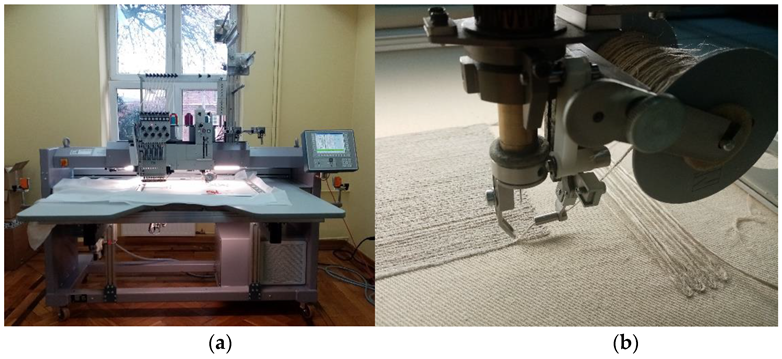
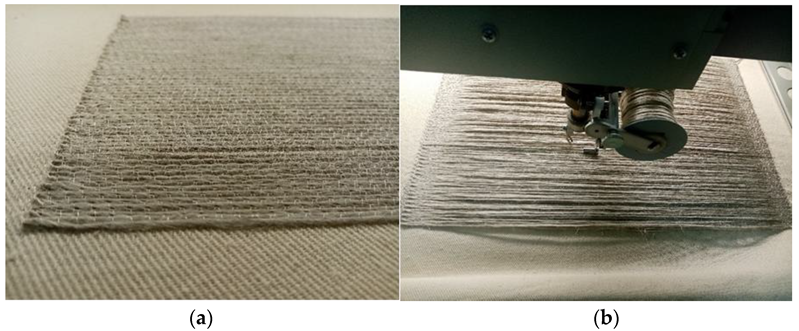
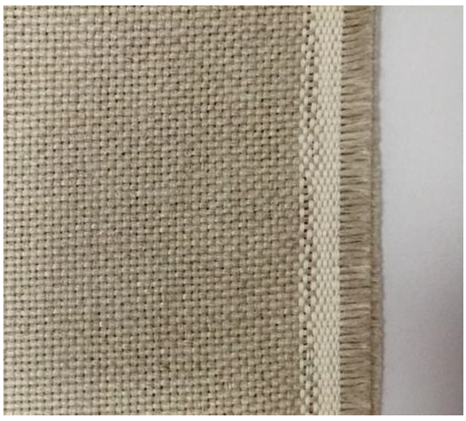



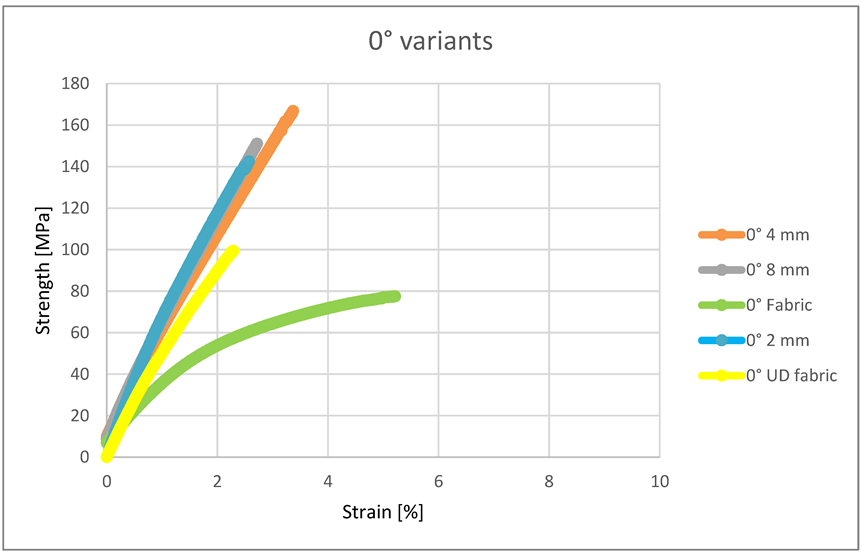
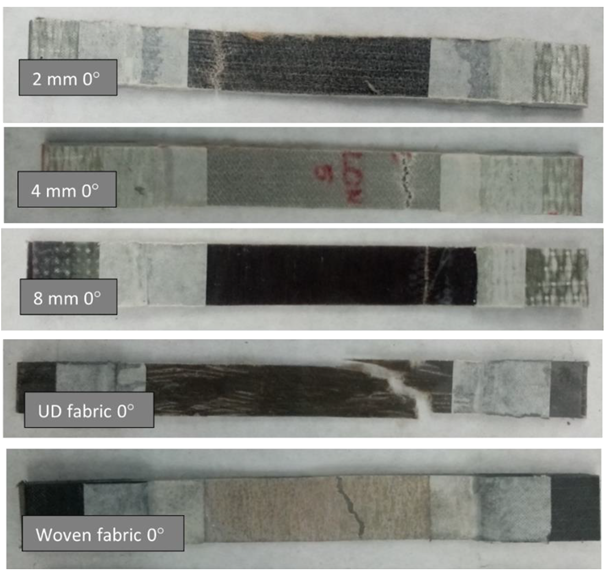
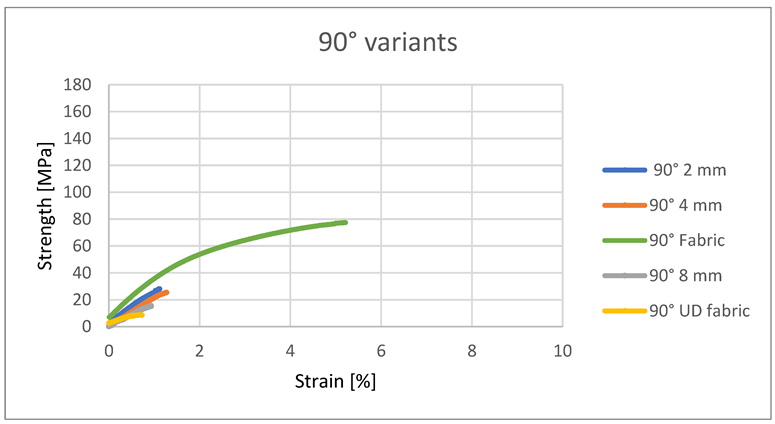

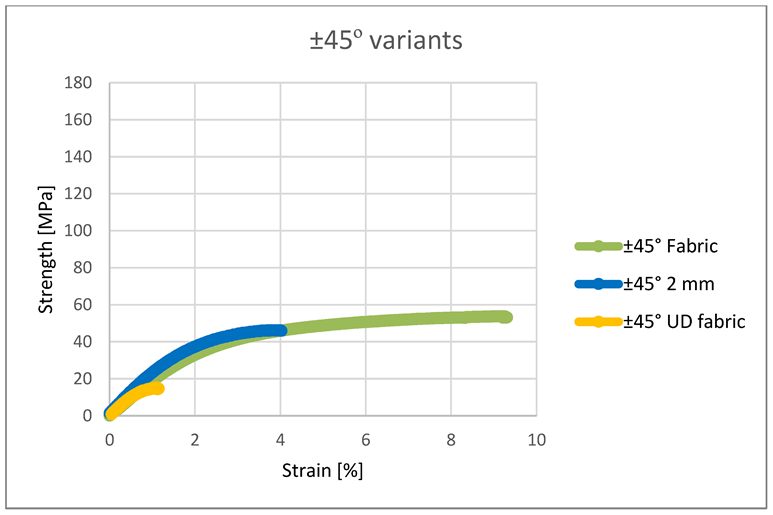

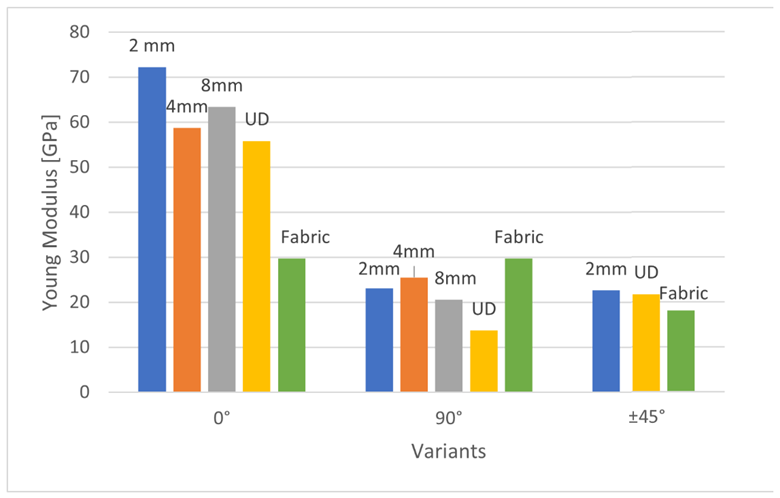
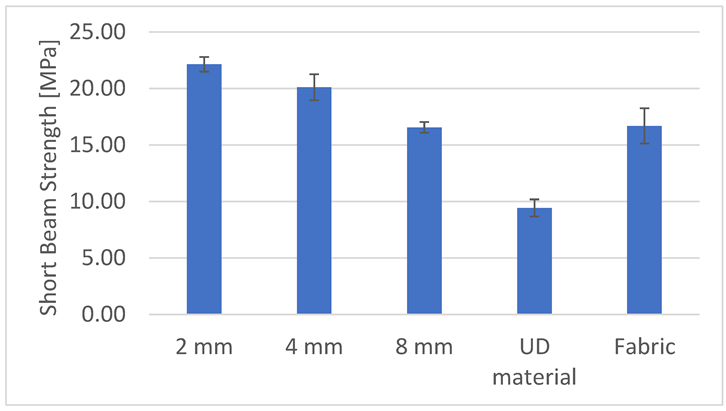
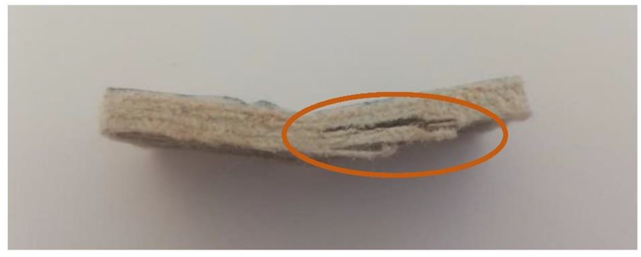
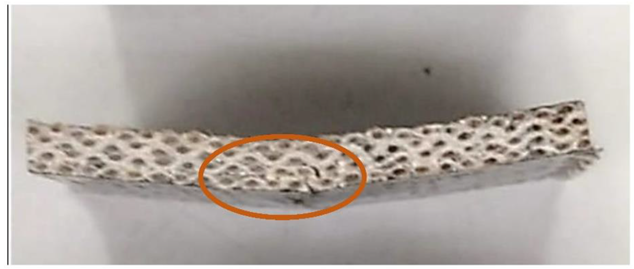
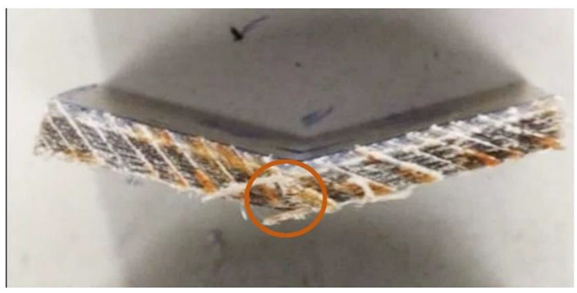
| Variant | Name | Orientation of Roving in Each Layer |
|---|---|---|
| Embroidery 0° 2 mm | 0° 2 mm | ││││ |
| Embroidery 0° 4 mm | 0° 4 mm | ││││ |
| Embroidery 0° 8 mm | 0° 8 mm | ││││ |
| Embroidery ±45° 2 mm | ±45° 2 mm |  |
| Embroidery 90° 2 mm | 90° 2 mm | ─ ─ ─ ─ |
| Embroidery 90° 4 mm | 90° 4 mm | ─ ─ ─ ─ |
| Embroidery 90° 8 mm | 90° 8 mm | ─ ─ ─ ─ |
| UD fabric 0° | 0° UD | ││││ |
| UD fabric ±45° | ±45° UD |  |
| UD fabric 90° | 90° UD | ─ ─ ─ ─ |
| Fabric 0°/90° | fabric 0°/90° |  |
| Fabric ±45° | fabric ±45° |  |
| Variant | Name |
|---|---|
| Embroidery 0° 2 mm | 41% |
| Embroidery 0° 4 mm | 38% |
| Embroidery 0° 8 mm | 34% |
| Embroidery ±45° 2 mm | 40% |
| Embroidery 90° 2 mm | 30% |
| Embroidery 90° 4 mm | 38% |
| Embroidery 90° 8 mm | 34% |
| UD fabric 0° | 56% |
| UD fabric ±45° | 52% |
| UD fabric 90° | 39% |
| Fabric 0°/90° | 42% |
| Fabric ±45° | 44% |
| Parameter | Value |
|---|---|
| grips distance | 100 mm |
| speed of testing | 1 mm/min |
| sample size | 250 mm × 25 mm × 3.5 mm |
| number of samples | 5 of each variant |
| Parameter | Value |
|---|---|
| distance between supports | 20 mm |
| speed of testing | 1 mm/min |
| sample size | 40 mm × 20 mm × 4 mm |
| number of samples | 5 of each variant |
Publisher’s Note: MDPI stays neutral with regard to jurisdictional claims in published maps and institutional affiliations. |
© 2022 by the authors. Licensee MDPI, Basel, Switzerland. This article is an open access article distributed under the terms and conditions of the Creative Commons Attribution (CC BY) license (https://creativecommons.org/licenses/by/4.0/).
Share and Cite
Poniecka, A.; Barburski, M.; Ranz, D.; Cuartero, J.; Miralbes, R. Comparison of Mechanical Properties of Composites Reinforced with Technical Embroidery, UD and Woven Fabric Made of Flax Fibers. Materials 2022, 15, 7469. https://doi.org/10.3390/ma15217469
Poniecka A, Barburski M, Ranz D, Cuartero J, Miralbes R. Comparison of Mechanical Properties of Composites Reinforced with Technical Embroidery, UD and Woven Fabric Made of Flax Fibers. Materials. 2022; 15(21):7469. https://doi.org/10.3390/ma15217469
Chicago/Turabian StylePoniecka, Agata, Marcin Barburski, David Ranz, Jesús Cuartero, and Ramon Miralbes. 2022. "Comparison of Mechanical Properties of Composites Reinforced with Technical Embroidery, UD and Woven Fabric Made of Flax Fibers" Materials 15, no. 21: 7469. https://doi.org/10.3390/ma15217469
APA StylePoniecka, A., Barburski, M., Ranz, D., Cuartero, J., & Miralbes, R. (2022). Comparison of Mechanical Properties of Composites Reinforced with Technical Embroidery, UD and Woven Fabric Made of Flax Fibers. Materials, 15(21), 7469. https://doi.org/10.3390/ma15217469








